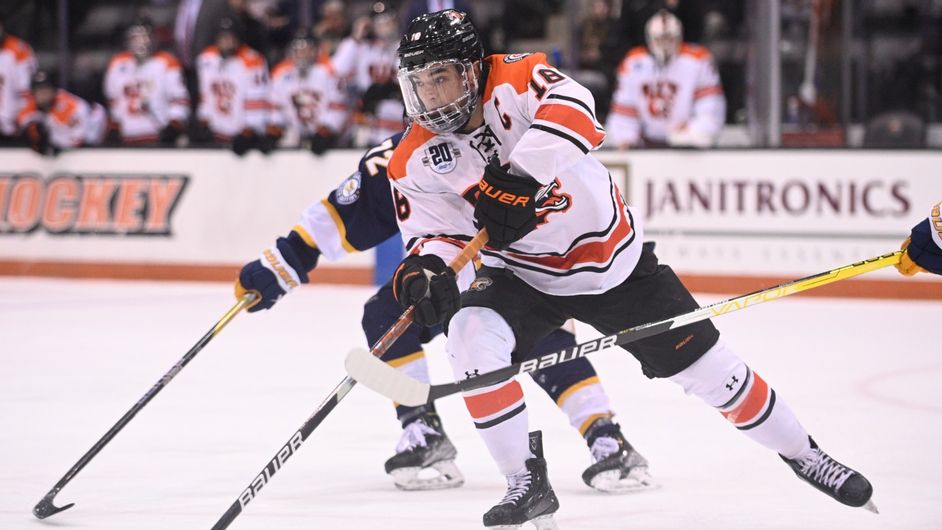
Each week during the season, we look at the big events and big games around Division I men’s college hockey in Tuesday Morning Quarterback.
Paula: Well, Jimmy, we’ve finished a very interesting first half of the season and a much-needed break for everyone involved. The schedule was light over the weekend, and no one plays again until the Great Lakes Invitational begins Dec. 27.
Last week, our good friends Ed Trefzger and Dan Rubin gave us their thoughts on the first half of the season – and I’m sure we’ll do a little bit of that ourselves today – but I’m looking ahead to the second half and what may come.
Maybe I’m looking forward rather than back because the small number of member teams really intensifies Big Ten play after Jan. 1, and I think there’s a bit of World Junior anticipation that propels me forward, but I am so invested in a couple of conference races already that it’s hard not to get ahead of myself a little.
Also, the PairWise Rankings are at the point of having gathered enough data that they merit some discussion.
I don’t want to deprive you of first-half observations if you want to make them, but I’m far more interested in this: what do we see now at the end of the first half that most likely provides a solid glimpse into 2023?
Jim: I don’t mind a little second-half prognostication.
I do see some interesting scenarios beginning to form. Merrimack in Hockey East is easily the most interesting story of the year, somewhat topping another league team in Connecticut, which had been the dark horse darling for much of the season.
I’m very impressed with what Bemidji State is doing in the CCHA, particularly after taking five of six points against Minnesota State this past weekend.
Not a lot surprises me in the Big Ten, ECAC Hockey or NCHC as the teams I expected near the top are there.
And then there is RIT. The Tigers are not just leading the Atlantic Hockey standings, but at 12-4-0, they are a PairWise bubble team and could be in the position, if they can’t close the deal in the AHA tournament, of possibly creating a second bid from Atlantic Hockey, something we haven’t seen in a decade.
Those are all the storylines I will watch as games restart right before the New Year. How about you?
Paula: RIT is a great story to follow in the second half because of their first-half success. It’s so tough for teams from Atlantic Hockey to play themselves into the NCAA Tournament directly without the conference playoff title, but I think that the Tigers have a good chance of doing just that – if they prove themselves to be an effective road team.
They have two games against Penn State to close 2022, a golden opportunity for a win against a team high in the PWR and RPI. That’s a home-and-home series with the first game in their own barn. Ten of their 18 remaining games are on the road, including a series against Arizona State – must-win hockey for the Tigers to remain in the PWR mix without having to rely on an autobid.
And wouldn’t it be fun to have two teams from Atlantic Hockey in the tourney?
I can’t tell you how much I’m looking forward to another photo finish in Hockey East, especially since Merrimack’s in the mix.
Bemidji’s not the only team impressing me in the CCHA. Michigan Tech took four of six points from Minnesota State in late November and the Huskies have one of the best defenses in the nation, allowing just over two goals a game. Bemidji hosts Michigan Tech in early February, so I anticipate a down-to-the-wire finish in the CCHA as well.
Speaking of Tech, I’ll be eager to see how the Great Lakes Invitational does Dec. 27-28 in Van Andel Arena. It’s very disappointing that the event has been moved out of an NHL arena. The GLI didn’t draw well at Little Caesars Arena, but I felt the Red Wings’ commitment to the event waned even in its final years at Joe Louis Arena. I love that Western Michigan and Ferris State are joining Michigan Tech and Michigan State, and I’m hoping that fans will show. I do think that Michigan State needs to emerge from the GLI with the title for second-half momentum and to avoid dropping in the PWR.
Are there holiday tournaments that you’re looking forward to, Jimmy?
Jim: Well, I think the two top tournament fields for holiday tournaments are the GLI, with three of the four teams ranked in the top 20 and all four at .500 or better. And the Desert Holiday Classic in Tempe, Ariz., at the new Mullett Arena, features two top 20 teams (for the record, Michigan Tech, a to-20 team, participates in both of these tournaments as they are scheduled a week apart).
For me, though, what is disheartening is how many of the legendary holiday tournaments are disappearing. The Mariucci Classic in Minnesota was one of the best tournaments every year. Vermont held its tournament for many years. The Denver Cup has disappeared. And even though short-lived, the tournament in Vegas was an awesome experience for teams every year in an emerging hockey market.
Talking with Derek Schooley on our USCHO Weekend Review podcast on Monday, he said the key is the cost. You need to fly/bus out three teams (sometimes four, say, in the case of the tournament in Milwaukee where even host Wisconsin needs accommodations) and house/provide meals for them all for a few days. If the tournament is off campus, there is additional costs.
Thus tournaments depend on sponsors, which understandable might not see enough payback for the overall cost of the event given that it can be difficult to draw crowds when students are nowhere near campus.
I also proposed that holiday tournaments should receive exemptions from the 34-game NCAA cap, similar to what the Ice Breaker tournament is given at the beginning of the season. That might make for an easier scheduling decision for coaches.
Paula: Those are excellent points about the tourneys, Jimmy – and, of course, Schooley is right (as he so often is about so many things). I agree that an exemption for holiday tournaments is a solid idea.
I am with you when it comes to lamenting the days of holiday tournaments past. At the risk of sounding like one of The Olds and shaking a fist at clouds for raining, one of the most exciting things about college hockey when I began covering in the mid-1990s was the holiday play.
There were great tournaments, as you said – the Mariucci Classic, the Catamount Cup, the Badger Showdown, the Denver Cup, the Rensselaer Holiday Tournament, even the Florida College Hockey Classic. Once upon a time, they provided a great in-season opportunity for nonconference play, a treat for fans and a good test for many teams.
They felt like special events and in some years a midseason taste of the NCAA tournament.
Even before the pandemic disrupted everything in 2020, I had already begun to feel – again at the risk of being one of “those people” – that college hockey had lost some of what was making it an appealing alternative to many other college sports, and the dwindling number of holiday tournaments played a part in that.
We have some significant tradeoff now, of course, in that so many college hockey games are accessible via network and streaming services – but I haven’t yet seen the evidence that this has done anything to make up for what was lost in allure, nor have I seen proof that the sport has grown its fanbase. I can’t speak to the revenue end of things.
Jim: Here is one thought I will leave everyone with, and this was told to me by a successful Division I men’s head coach. He loved to play holiday tournaments because, in his opinion, these events mimicked an NCAA regional.
You had to play two games in two days to win something. Game times weren’t always 7 p.m. as so many teams are used to throughout the year. You might get a 1 p.m. or 3:30 p.m. start, just like you would in a regional.
Now with NCAA regionals being split over three days with a day off between games, these seasonal events don’t mimic a regional quite as well. But the change of routines for a players, I though, are excellent.
This season, we’ll at least get four tournaments over the next few weeks – the aforementioned GLI, the Quik Trip Holiday Face-Off in Milwaukee, the long-standing Ledyard Bank Tournament at Dartmouth and the Desert Classic in sunny Tempe.
All great events that I know you and I and many college hockey fans can appreciate!


